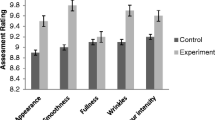Abstract
Today, sustainable production has become an important concept. As the trends in the world bring about the widespread use of used-looking clothes, it has become mandatory to apply processes such as spray rodeo, which is the process done by spraying permanganate with a special spray gun or applying it with a brush to the desired area. However, permanganate has risk of causing irritation to the face and eyes, and cough, mucosal irritations, shortness of breath, etc. Therefore, it is of great importance to replace permanganate with clean alternatives. In this study, it was aimed to obtain high bleaching efficiency via laser-activated organic bleaching process and thus to obtain permanganate-like results in a sustainable way. It was found that the effects of organic bleaching agent concentration and pixel time on the degree of color fading are statistically significant and the optimum color fading could be achieved at 30% bleaching agent concentration and 300 μs pixel time. However, the bleaching agent concentration and/or pixel time can be changed according to the desired degree of color fading. Results indicated that by using laser-activated organic bleaching process, it is possible to obtain nearly same color fading effects with that of permanganate bleaching, which means a cleaner alternative has been developed.



Similar content being viewed by others
References
M. Toksöz, S. Mezarcıöz, Çukurova Ü. Müh. Mim. Fak. Dergisi. 28(2), 141 (2013)
H. Jamshaid, N. Asfand, A.W. Rajput, S.A. Basra, B. Zahid, A. Ali, Ind. Text. 71(1), 3 (2020)
D. Arjun, J. Hiranmayee, M.N. Farheen, Int. J. Ind. Eng. 3(4), 25 (2013)
R.T. Oğulata, A. Nergis, Çukurova Ü. Müh. Mim. Fak. Dergisi. 31(2), 421 (2016)
İ.C. Bağıran, Denim Yıkamada Karşılaşılan Sorunlar ve Bunlara Yönelik Çözüm Önerileri, Ege Üniversitesi Fen Bilimleri Enstitüsü, MSc Thesis, İzmir, 2011
O. Yılmaz, Tekstil Sektöründe Kimyasal Risk Etmenleri ve Sektöre Yönelik SGK Teftiş Verilerinin Analizi, Cumhuriyet Üniversitesi Fen Bilimleri Enstitüsü İş Sağlığı ve Güvenliği Ana Bilim Dalı, MSc Thesis, Sivas, 2022
M.Z. Hasan, M. Rokonuzzaman, A. Razzaque, M.M. Moshwan, M.H. Reza, S. Rana, B. Basak, A.K.M.A.H. Asif, Int. J. Ind. Syst. 6(4), 59 (2021)
J.M. Yao, S.N. Wei, Adv. Mater. Res. 627, 190 (2012)
E. Khalil, A. Rahman, M. Solaiman, AASCIT Commun. 2(6), 271 (2015)
R.T. Oğulata, A. Nergis, Çukurova Ü. Müh. Mim. Fak. Dergisi 32(4), 87 (2017)
D. Wei, D. Zuo, H. Gan, C. Yi, Appl. Sci. 9(21), 4662 (2019)
M.A. Rashid, M.S. Miah, M.A.B. Siddique, M.A. Hannan, J. Tex. App. Tech. Manag. 11(3), 1 (2020)
M. Siddiquee, A. Moula, J. Saha, M. Kabir Khan, Z. Kaisar, A. Roy, J. Tex. Sci. Tech. 8, 149 (2022)
U.K. Sarker, M.N. Kawser, A. Rahim, A. Al Parvez, M.I. Shahid, Int. J. Curr. Eng. Technol. 11(5), 516 (2021)
A. Ben Fraj, B. Jaouachi, Color. Technol. 137(6), 678 (2021)
M.Z. Hasan, A.K.M.A.H. Asif, A. Razzaque, M.R. Hasan, S. Sur, M.O. Faruque, J. Mater. Sci. Chem. Eng. 9(1), 1 (2021)
S. Üstüntağ, H.G. Türksoy, Ind. Text. 70(3), 259 (2019)
N. Ibrahim, E. El-Zairy, S. Barakat, B.M. Eid, Egypt. J. Chem. 65(13), 39 (2022)
R. Nayak, M. George, L. Jajpura, A. Khandual, T. Panwar, Curr. Opin. Green Sustain. Chem. 38, 1 (2022)
T. Dascalu, S.E. Acosta-Ortiz, M. Ortiz-Morales, I. Compean, Opt. Lasers Eng. 34(3), 179 (2000)
M. Ortiz-Morales, M. Poterasu, S.E. Acosta-Ortiz, I. Compean, M.R. Hernandez-Alvarado, Opt. Lasers Eng. 39(1), 15 (2003)
A.T. Özgüney, G. Özçelik, K. Özkaya, Tekst Konfeksiyon 19(2), 133 (2009)
C.W. Kan, J. Clean. Prod. 66, 624 (2014)
C.W. Kan, Fibers Polym. 15(2), 426 (2014)
W. TalatMadian, B. GebalyGabr, IJSRET 5(6), 332 (2016)
M. Juciene, V. Vytautas Urbelis, Z. Juchneviciene, V. Saceviciene, V. Dobilaite, Int. J. Cloth. Sci. 30(4), 588 (2018)
A. Sakib, T. Islam, S. Islam, M. Ahmed, S. Ali, JTEFT 5(6), 288 (2019)
P.D. Venkatraman, C.M. Liauw, Opt. Laser Technol. 111(April), 701 (2019)
E.S. Dalbaşı, G. Özçelik Kayseri, A.A. İlleez, Opt. Laser Technol. 118, 28 (2019)
B.R. Büyükbayraktar, G.E. Batur, Industria Textila 72(4), 418 (2021)
BS EN ISO 13937-1:2000, Textiles. Tear properties of fabrics Determination of tear force using ballistic pendulum method (Elmendorf)
ASTM D5034-21, Standard Test Method for Breaking Strength and Elongation of Textile Fabrics (Grab Test)
Acknowledgements
We would like to thank Yavuz Sevim, for his kind help during experimental studies.
Funding
This research did not receive any specific grant from funding agencies in the public, commercial, or not-for-profit sectors.
Author information
Authors and Affiliations
Corresponding author
Ethics declarations
Conflict of interest
The authors declare no conflicts of interest/competing interests.
Availability of data and materials
Not applicable.
Code availability
Not applicable.
Rights and permissions
Springer Nature or its licensor (e.g. a society or other partner) holds exclusive rights to this article under a publishing agreement with the author(s) or other rightsholder(s); author self-archiving of the accepted manuscript version of this article is solely governed by the terms of such publishing agreement and applicable law.
About this article
Cite this article
Atav, R., Gündüz, Ö., Yaz, S. et al. Laser-Activated Organic Bleaching Process as an Environmentally Friendly Clean Alternative to Permanganate Bleaching in Denim Washing. Fibers Polym 24, 2725–2730 (2023). https://doi.org/10.1007/s12221-023-00251-3
Received:
Revised:
Accepted:
Published:
Issue Date:
DOI: https://doi.org/10.1007/s12221-023-00251-3




